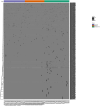Phosphoproteomics analysis of serum from dogs affected with pulmonary hypertension secondary to degenerative mitral valve disease
- PMID: 38708342
- PMCID: PMC11067895
- DOI: 10.7717/peerj.17186
Phosphoproteomics analysis of serum from dogs affected with pulmonary hypertension secondary to degenerative mitral valve disease
Abstract
Pulmonary hypertension (PH), a common complication in dogs affected by degenerative mitral valve disease (DMVD), is a progressive disorder characterized by increased pulmonary arterial pressure (PAP) and pulmonary vascular remodeling. Phosphorylation of proteins, impacting vascular function and cell proliferation, might play a role in the development and progression of PH. Unlike gene or protein studies, phosphoproteomic focuses on active proteins that function as end-target proteins within signaling cascades. Studying phosphorylated proteins can reveal active contributors to PH development. Early diagnosis of PH is crucial for effective management and improved clinical outcomes. This study aimed to identify potential serum biomarkers for diagnosing PH in dogs affected with DMVD using a phosphoproteomic approach. Serum samples were collected from healthy control dogs (n = 28), dogs with DMVD (n = 24), and dogs with DMVD and PH (n = 29). Phosphoproteins were enriched from the serum samples and analyzed using liquid chromatography-tandem mass spectrometry (LC-MS/MS). Data analysis was performed to identify uniquely expressed phosphoproteins in each group and differentially expressed phosphoproteins among groups. Phosphoproteomic analysis revealed nine uniquely expressed phosphoproteins in the serum of dogs in the DMVD+PH group and 15 differentially upregulated phosphoproteins in the DMVD+PH group compared to the DMVD group. The phosphoproteins previously implicated in PH and associated with pulmonary arterial remodeling, including small nuclear ribonucleoprotein G (SNRPG), alpha-2-macroglobulin (A2M), zinc finger and BTB domain containing 42 (ZBTB42), hemopexin (HPX), serotransferrin (TRF) and complement C3 (C3), were focused on. Their unique expression and differential upregulation in the serum of DMVD dogs with PH suggest their potential as biomarkers for PH diagnosis. In conclusion, this phosphoproteomic study identified uniquely expressed and differentially upregulated phosphoproteins in the serum of DMVD dogs with PH. Further studies are warranted to validate the diagnostic utility of these phosphoproteins.
Keywords: Biomarkers; Degenerative mitral valve disease; Dogs; Phosphoproteomics; Proteomics; Pulmonary hypertension; Serum.
© 2024 Sakarin et al.
Conflict of interest statement
The authors declare that they have no competing interests.
Figures







Similar articles
-
Proteomic analysis of pulmonary arteries and lung tissues from dogs affected with pulmonary hypertension secondary to degenerative mitral valve disease.PLoS One. 2024 Jan 5;19(1):e0296068. doi: 10.1371/journal.pone.0296068. eCollection 2024. PLoS One. 2024. PMID: 38181036 Free PMC article.
-
Histopathological changes of pulmonary vascular remodeling in dogs affected with pulmonary hypertension secondary to degenerative mitral valve disease.J Vet Cardiol. 2021 Aug;36:141-152. doi: 10.1016/j.jvc.2021.06.005. Epub 2021 Jun 24. J Vet Cardiol. 2021. PMID: 34284267
-
Expression of apoptotic proteins in the pulmonary artery of dogs with pulmonary hypertension secondary to degenerative mitral valve disease.Res Vet Sci. 2022 Jul;145:238-247. doi: 10.1016/j.rvsc.2022.03.006. Epub 2022 Mar 8. Res Vet Sci. 2022. PMID: 35286943
-
Insights into serotonin signaling mechanisms associated with canine degenerative mitral valve disease.J Vet Intern Med. 2010 Jan-Feb;24(1):27-36. doi: 10.1111/j.1939-1676.2009.0411.x. J Vet Intern Med. 2010. PMID: 19912520 Review.
-
Signaling pathways in mitral valve degeneration.J Vet Cardiol. 2012 Mar;14(1):7-17. doi: 10.1016/j.jvc.2011.12.001. Epub 2012 Feb 23. J Vet Cardiol. 2012. PMID: 22364692 Review.
Cited by
-
Phosphoproteomic profiling of feline mammary carcinoma: Insights into tumor grading and potential therapeutic targets.PLoS One. 2025 Aug 21;20(8):e0330520. doi: 10.1371/journal.pone.0330520. eCollection 2025. PLoS One. 2025. PMID: 40839607 Free PMC article.
References
-
- Abooshahab R, Hooshmand K, Razavi SA, Gholami M, Sanoie M, Hedayati M. Plasma metabolic profiling of human thyroid nodules by gas chromatography-mass spectrometry (GC-MS)-based untargeted metabolomics. Frontiers in Cell and Developmental Biology. 2020;8:385. doi: 10.3389/fcell.2020.00385. - DOI - PMC - PubMed
Publication types
MeSH terms
Substances
LinkOut - more resources
Full Text Sources
Medical
Research Materials
Miscellaneous

